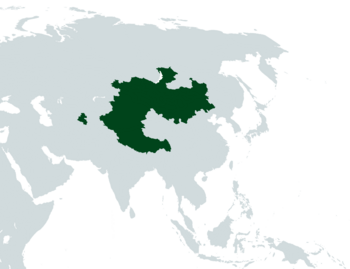Mongol Uls: Difference between revisions
Mongol Uls (talk | contribs) No edit summary |
Mongol Uls (talk | contribs) No edit summary |
||
| Line 18: | Line 18: | ||
|regional_languages = | |regional_languages = | ||
|ethnic_groups = {{vunblist | |ethnic_groups = {{vunblist | ||
| 34% Khalkha Mongol | | 34% [[wikipedia:Khalkha Mongol|Khalkha]] | ||
| 33% Uzbek | | 33% [[wikipedia:Uzbeks|Uzbek]] | ||
| 10% Uyghur | | 10% [[wikipedia:Uyghurs|Uyghur]] | ||
| 7% Other Turkic | | 7% Other Turkic | ||
| 6% Tibetan | | 6% [[wikipedia:Tibetans|Tibetan]] | ||
| 5% Other Mongol | | 5% Other Mongol | ||
| 4% Chinese | | 4% [[wikipedia:Han Chinese|Han Chinese]] | ||
| 1% Other | | 1% Other | ||
}} | }} | ||
Revision as of 04:03, 4 December 2023
Khanate of the Mongol Uls Moŋɣol Ulusyn Khanlig | |
|---|---|
| Anthem: Chinggis Khaanii Magtaal | |
 | |
| Capital and largest city | Kharkorin |
| Official languages | Khalkha Uzbek |
| Recognised national languages | Tuvan Buryat Tibetan Uyghur |
| Ethnic groups |
|
| Demonym(s) | Mongol |
| Government | Asymmetrical federal parliamentary real union |
• Bogd Gegeen | Manduul Temujin |
• Prime Minister | Etsegh-ek Törin |
| Legislature | Kurultai |
| History | |
• Onon Kurultai | 1206 CE |
• Qing Conquest | 1758 CE |
• Soviet Occupation | 1921 |
• Coronation of Manduul Temujin | 2019 |
| Area | |
• Total | 6,400,000 km2 (2,500,000 sq mi) |
| Population | |
• 2023 estimate | 59,978,231 |
• 2020 census | 56,023,745 |
| GDP (nominal) | 2020 estimate |
• Total | $199 billion |
• Per capita | $3321.46 |
| Currency | Sum (mns) (MNS) |
| Date format | dd-mm-yy |
| Driving side | left |
| Internet TLD | .ml |
The Mongol Uls, officially the Khanate of the Mongol Uls (Khalkha; Moŋɣol Ulusyn Khanlig), is a nation located in Central Asia. Composed of its heartland, referred to as Mongolia, as well as the federacy of Gurkaniyan, the free city of Kharkhorin, and areas under the jurisdiction of the militant Second Golden Horde, the Khanate claims the legacy of the ancient Mongol Empire.
While a Mongol state in some form has existed since the Onon Kurultai in 1206 CE, the present-day Khanate was created in 2019, when Nyamaagiin Khaltar was recognised by the 14th Dalai Lama as the 10th Jebtsundamba Khutuktu, and hence the Bogd Gegeen, heir to the Bogd Khan. After a lengthy public debate, a referendum led to Khaltar being installed as Manduul Temujin, the 10th Bogd Gegeen and Khan of All Mongolia, the head of state of a new Mongol Khanate. In 2021, the Mongol Uls announced plans to form a real union with the newly-established Turkic state of Gurkaniyan, and with a previously-sovereign militia known as the Second Golden Horde. Together, the three entities formed what became known as the current Khanate of the Mongol Uls.
The Khanate of the Mongol Uls is the world's second-largest country by land area, although it is very sparsely populated. Its wide jurisdiction and strategic location have led to its controlling a powerful military position, and it is beginning to be considered to be a great power. Its entrance into a personal union with Russia in 2022 and its significant sway over both the Turkic Union and many Chinese military factions have led to it increasingly becoming an international powerbroker.
Etymology
The term "Mongol Uls" can be roughly translated as "Mongol State". The Mongol Uls is often referred to by the metonym of "Mongolia"; however, this is neither the Khanate's official name nor an accurate description, as the Khanate controls territories in areas that are far from the Mongol steppe. Rather, "Mongolia" is a designation for a geographical region within the greater Khanate, which is used for demographic and electoral purposes.